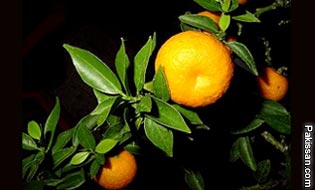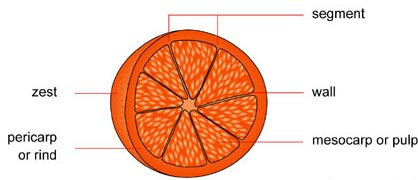|
Citrus
quality to meet global demand
Home
By Dr Sardar Riaz A. Khan
CITRUS comprizes of different edible fruit species like
mandarin, oranges, grapefruit, lemons and limes. Out of
6,52,000 hectares under fruits, about 28 per cent is under
citrus having a share of 30 per cent in total production of
57,42,000 tons.
 About
94 per cent of citrus production area is in Punjab, 2.3 per
cent in Sindh, 2.4 per cent in the NWFP, and 1.3 per cent in
Balochistan out of the total 1,71,000 hectares. About
94 per cent of citrus production area is in Punjab, 2.3 per
cent in Sindh, 2.4 per cent in the NWFP, and 1.3 per cent in
Balochistan out of the total 1,71,000 hectares.
Out of the total production of 17,02,800 tons of citrus the
share of Punjab is 95.5 per cent; of Sindh 1.6 per cent; of
the NWFP 2.2 per cent; and of Balochistan 0.7 per cent.
Punjab’s share is the biggest due to its climate. Sargodha,
Sahiwal and Toba Tek Singh are major citrus producing
districts in Punjab. Kinoo mandarin, being an exportable
fruit, has a production target of 70 per cent of the total. It
is one of the major sources of income to small and medium size
growers and traders.
Pakistan is among the 10 largest citrus producing countries of
the world. Citrus, till 1974-75 was the second largest fruit
after mango both in area and production but took the first
position after the introduction of kinoo variety by the then
Agricultural College and Research Institute, Lyallpur now the
University of Agriculture, Faisalabad.
The parent cross of this variety was made between “King” and
“Willow leaf” varieties by H.B Frost in 1915 at the Citrus
Research Centre of the University of California Riverside, US
and was subsequently released in 1935. It was introduced in
Punjab and flourished well in that environment. Further
improvement in taste and flavour made it popular within and
outside Pakistan. Its demand has increased in the Middle East,
the Gulf States, Europe and the Far East eventually raising
the export earnings.
Citrus production worldwide is around 104 million metric tons
per annum with Brazil being the largest grower of 19.2 million
metric tons followed by the US. However, the US leads the
world with an average yield of 30 tons per hectare followed by
Brazil with of 20-25 tons, and China 18-20 million tons.
Though Pakistan is the fifth largest kinoo exporting countries
but its average yield per hectare is 9.2 tons per hectare,
while of all citrus fruits its is 9.4 tons. It reflects on
poor exploitation of production potentials.
Though the demand of Pakistani fruits is enormous but our
exporting potential is a mere eight per cent due to a big
chunk of 25 per cent going to waste on account of poor
management during harvesting, transportation, packaging, and
storage. There is a need to follow the well established
production technology, improve post harvesting, packaging,
transportation, and storage facilities. The storage life of
fruits can be extended by 50-100 per cent by using wax
technology and of kinoo up to 30 days.
Pakistani kinoo has a great demand in international market but
a higher number of seeds are one big constraint with an
average 12.2 seeds per berry as compared to 11.2 in musambi,
9.5 in feutral and 8.8 in succari. Seedless cultivars are
preferred by the international consumers.
Seedless variety of Washington Naval Orange and Marsh variety
of grapefruit is developed in the US and the Citrus Research
Centre in the University of California, Riverside is engaged
in developing seedless kinoo variety which may not be costly
to import but could challenge our variety. The horticulture
scientists should develop seedless fruit to meet the future
challenges.
 Seedless
fruits fetch premium price and there are two variable
approaches to produce seedless kinoo. The conventional
interploid (2N multiplied by 4N) hybridization can be combined
with tissue culture procedures to produce triploids (3N) which
are seedless, and the other radiation breeding. Both these
approaches can be employed in widening the fruit’s scope. Seedless
fruits fetch premium price and there are two variable
approaches to produce seedless kinoo. The conventional
interploid (2N multiplied by 4N) hybridization can be combined
with tissue culture procedures to produce triploids (3N) which
are seedless, and the other radiation breeding. Both these
approaches can be employed in widening the fruit’s scope.
However, in both these approaches more than one generation of
fruit trees are required to be raised which takes many years.
The normal seed of kinoo is diploid (2N) and tetraploid (4N)
introduced by the University of Agriculture Faisalabad in 1988
as the second required parent for interpoid hybridization.
It took several years to get triploids (seedless) cultivars
which started to flower and fruit. But these require several
years for empirical testing before being recommending to
growers for replacing the seeded kinoo. Due to official snags,
most of this valuable plant material was destroyed.
A competent horticulture scientist has established an
Institute of Horticulture Sciences in the University of
Agriculture, Faisalabad. It follows both breeding and
biotechnological approaches in collaboration with the National
Institute of Biotechnology and Genetic Engineering, Faisalabad.
If saved from further official snags, it has the potential of
meeting the challenges of producing commercially acceptable
seedless kinoo or other alternate citrus varieties.
Kinoo has the longest growing period and is a late maturing
variety with short crushing and processing period. This causes
problems to citrus industry. Due to soft skin, the fruit is
damaged during harvesting and transportation thus causing
heavy post harvest losses.
The horticulture scientist should consider using the
biotechnological and radiation technology to produce early and
mid-season seedless kinoo varieties with better skin to
overcome these problems.
The growers suffer from poor quality and low producing
seedlings purchased from the unspecified nurseries using
inferior and infected budwood. Orchards raised from such
nurseries are short-lived and produce a fraction of the
potential yield. The loss due to poor quality seed further
reduces the income of growers.
The world’s best fruit growing countries have self- sustaining
certification programme backed by the government agencies and
research institutes which provide longer production life to
orchards with yields three times more than ours.
The policy makers should consider implementing a nursery
certification programme to produce long duration orchards with
high production capacity of quality fruits. Another problem is
the post-harvest losses which inflict heavy foreign exchange
losses due to the rejection of consignments.
Though Pakistan is among top 10 producers but its current
export is much below than the production. Proper production
technology, marketing and high quality should be focussed for
competing in international markets. Another area is an
increase in export of frozen concentrated juices of citrus and
other fruits.
Russia has offered Pakistan to cut 25 per cent in import duty
on 26 items, including fruits and fruit juices. Similarly,
China has shown interest in importing Pakistani mango dipped
in hot water. The policy makers thus should exploit this
opportunity in the best national interest.
.
Courtesy: The DAWN
|
Pakissan.com;
|